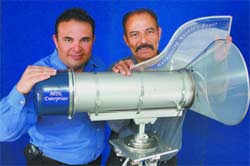A tiny wind-powered generator soon could help Navajo families light up their homes.
The device, created by Albuquerque inventor and entrepreneur Michael Baca, is designed to harness wind energy for households in remote rural areas like the Navajo Nation where it's often too costly for utilities to provide service.
"Most Navajos use small generators -- even car generators -- to power their homes because it's too expensive for utilities to connect them to the grid," Baca said. "They need a local source of energy that's practical and economical, so I created a small, private wind generator that they can install, similar to solar panels."
Baca, who formed Native Power Systems LLC with two partners to market the generator, plans to work with Ktech Corp. to perfect the device. Once finalized, Native Power aims to license the technology to the Navajo Nation for direct manufacture and distribution by the tribe.
Baca and Ortiz demonstrated the generator for the first time at Ktech headquarters in Albuquerque on March 28 in a meeting with Navajo officials and Ktech engineers.
"It was a meet-and-greet to get everybody in the same room to look at it," Ortiz said.
The generator is a tube-shaped device that sits on a tripod. It's just 22 inches long and 7.5 inches in diameter.
Unlike standard wind turbines -- which rely on spinning blades to generate electricity -- Baca's system "captures" wind by channeling it through the tube, which contains a spiral strip inside. The strip rapidly rotates as wind blows through, powering a small generator attached to the other end.
A special cap at the entrance helps straighten out and speed up air flow in the tube much the way a cowling does on a jet engine, Baca said.
"The design improves and speeds up the air flow inside, building more power for the generator," Baca said. "This is the first design that I know of that actually captures the wind."
Rick Blose, Ktech manager of engineering development, said Native Power has made a good, operational prototype that now needs to be scaled up to generate power for a home.
"Baca's unit produces about 300 miliwatts of power now, which is pretty small," Blose said. "We need to scale it up enough to produce one to two kilowatts."
Ktech will analyze design changes, scale up the prototype, and then assess durability in severe weather. All that could take 18-20 months and up to $1.5 million, Blose said.
Once a working model is built, Native Power would integrate the generator into a multifaceted home-power system that would include solar panels, as well as a small gas generator for when there's no wind or sun.
"We want to make it a three-part, on-site generation system," Baca said. "We don't know the price yet, because it depends on the materials used and the engineering changes Ktech makes, but we expect the cost of the wind generator to be compatible with solar panels."

